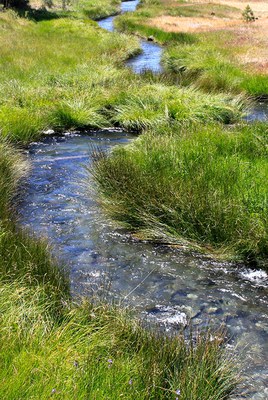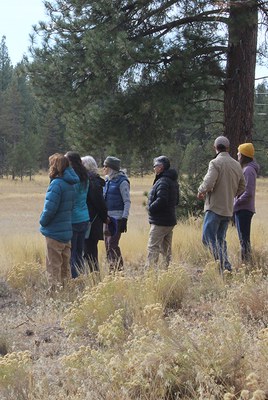The Land Trust is so excited about our new Paulina Creek Preserve near La Pine, Oregon and Newberry National Volcanic Monument. From amazing natural features to future community connections, there is a lot to explore! Here are five of the coolest things about Paulina Creek Preserve:
1. Wet and Dry Meadows. Paulina Creek Preserve currently contains 110 acres of meadows, about 10% of the entire Preserve. These meadows, also referred to as the Paulina Prairie, contain both wet and dry meadows. Healthy wet meadows are saturated by water for part or all of the growing season. Instead of having standing water, though, they act like sponges, helping to store water underground. They offer incredibly rich habitat, diverse streams and side channels, and cover for wildlife. Paulina Creek Preserve also contains dry meadows. These meadows are dominated by drier plants like grasses and wildflowers. Dry meadows are also biologically rich and support many types of plants that will not thrive under a canopy of trees (think bitterbrush, rabbitbrush, etc). Deer and elk use dry meadows for browsing grasses, and raptors hunt in these open areas. Learn more about wet and dry meadows.
3. Paulina Creek. More than three miles of Paulina Creek flows through the Preserve. The Creek begins 8.5 miles east, exiting Paulina Lake at an elevation of 6,330 feet. From there, Paulina Creek tumbles down Outlet Falls, Paulina Creek Falls, Pipeline Falls, Footbridge Fall, and McKay Falls (wow, that’s a lot of waterfalls!), before reaching Paulina Creek Preserve at around 4,250 feet. Paulina Creek provides important cold-water habitat in the summer to fish like bull and rainbow trout, as well as to macroinvertebrates.
4. Community Connections. Native Americans have been connected to land now known as Paulina Creek Preserve since time immemorial. The Klamath, Tenino, Northern Molala, Northern Paiute, and others used the area seasonally to hunt, fish, gather foods, and trade. Paulina Creek Preserve is within the lands ceded to the United States by the Klamath Tribes and the land has cultural significance to many tribes across the state.
As the Land Trust works to plan for the future of Paulina Creek Preserve, we look forward to involving local communities in the planning process. We are working with the Klamath Tribes, the Confederated Tribes of Warm Springs, and others to develop strategies for managing and restoring the property, as well as for sharing the history of the people who have cared for this land since time immemorial. We will also be holding a series of community conversations to discuss community values around the Preserve. Once the Land Trust can establish trails and access points, we hope to connect these trails with Newberry National Volcanic Monument trails and other local trailheads.
5. Climate Resilience. Paulina Creek Preserve is an important refuge for a warming climate. Bordered by National Forest lands to the north and east, the Preserve can help provide migration pathways for wildlife habitat to move freely across the landscape as the climate changes. The wet meadow at the Preserve also acts as a carbon sink, removing carbon from the atmosphere and helping mitigate the impacts of climate change.
We look forward to sharing these features of Paulina Creek Preserve with you in person!
Learn more:
- Paulina Creek Preserve Virtual Tour
- About Paulina Creek Preserve
- Building the Future of Paulina Creek Preserve


